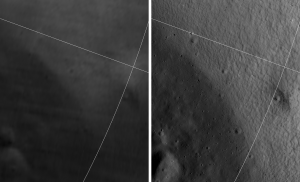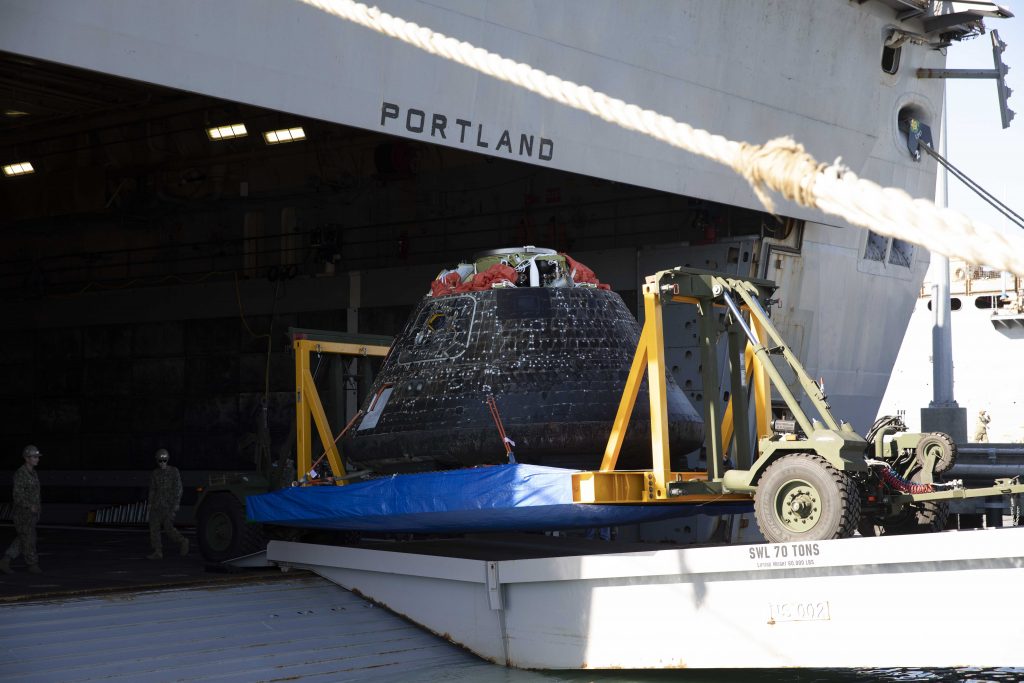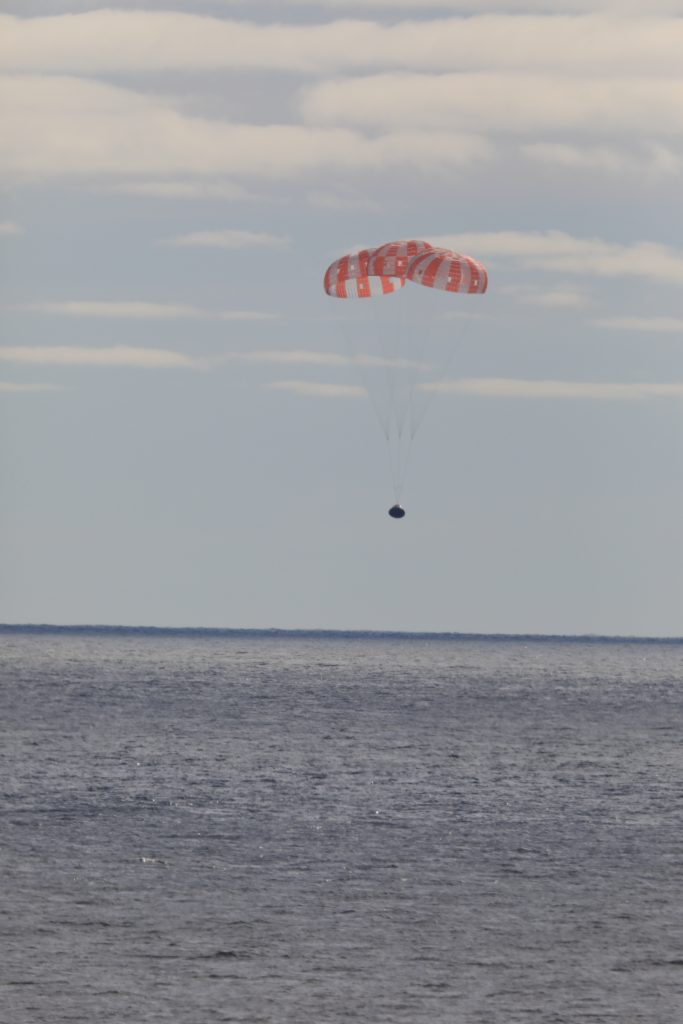NASA and the Canadian Space Agency (CSA) announced the four astronauts who will venture around the Moon on Artemis II, the first crewed mission on NASA’s path to establishing a long-term presence at the Moon for science and exploration through Artemis.
Artemis II Moon Astronauts to be Named April 3
NASA and CSA (Canadian Space Agency) will announce during an event at 11 a.m. EDT on Monday, April 3, from NASA Johnson Space Center’s Ellington Field in Houston, the four astronauts who will venture around the Moon on Artemis II. Traveling aboard NASA’s Orion spacecraft and launching on the Space Launch System rocket, the mission is the first crewed flight test on the agency’s path to establishing a long-term scientific and human presence on the lunar surface. The event will air on NASA Television, the NASA app, and the agency’s website.
Watch the video in Spanish.
NASA’s ShadowCam Images Permanently Shadowed Regions from Lunar Orbit
With the success of NASA’s Artemis I launch, the previously unexplored shadowy regions near the lunar South Pole where Artemis astronauts will land in 2025, are more within our reach than ever before.
One instrument that will support these future lunar exploration efforts is a hypersensitive optical camera called ShadowCam. ShadowCam is one of six instruments on board the Korea Aerospace Research Institute (KARI)’s Korea Pathfinder Lunar Orbiter, known as Danuri, which launched in August 2022 and entered lunar orbit last December.
Previous cameras in lunar orbit were designed to acquire images of sunlit surfaces. Developed by Malin Space Science Systems and Arizona State University, ShadowCam’s primary function is to collect images within permanently shadowed regions near the lunar poles. These areas never receive direct sunlight and are thought to contain water ice – a significant resource for exploration that can be used as fuel or oxygen and for other habitation applications.
Building on cameras developed for NASA’s Lunar Reconnaissance Orbiter, ShadowCam is 200 times more light-sensitive and is therefore able to capture detailed images within permanently shadowed regions – even in the absence of direct light – by using the light that is reflected off nearby geologic features such as mountains or the walls of craters.

In addition to mapping the light reflected by permanently shadowed regions to search for evidence of ice deposits, ShadowCam will also observe seasonal changes and measure the terrain inside the craters, all in service of science and future lunar exploration efforts. The high-resolution images could help scientists learn more about how the Moon has evolved, how water is trapped and preserved in permanently shadowed regions, and could help inform site selection and exploration planning for Artemis missions.
Since Danuri entered lunar orbit, ShadowCam has been in an operational checkout period, during which it has been collecting dozens of images of the lunar polar regions, including an image of Shackleton Crater, to calibrate and test its functionality. Following this checkout period, which will conclude later this month, ShadowCam will start its campaign to capture images of shadowed terrain as Danuri routinely passes over them during the planned mission of 11 months.
Read more about ShadowCam and Danuri.
CAPSTONE to Test Technologies After Recovery from Communications Issue
NASA’s CAPSTONE – short for Cislunar Autonomous Positioning System Technology Operations and Navigation Experiment – is in good health following a communications issue that began in late January, and the mission team is preparing for upcoming technology demonstration tests.
Beginning Jan. 26, CAPSTONE was unable to receive commands from ground operators. The spacecraft remained overall healthy and on-course throughout the issue, sending telemetry data back to Earth. On Feb. 6, an automatic command-loss timer rebooted CAPSTONE, clearing the issue and restoring two-way communication between CAPSTONE and the ground.
The CAPSTONE team, led by Advanced Space, is now preparing for continued testing of the spacecraft’s Cislunar Autonomous Positioning System, or CAPS, and other technology demonstrations.
CAPS is a navigation technology developed by Advanced Space that uses data between two or more spacecraft to pinpoint a satellite’s location in space. The test will involve two spacecraft: CAPSTONE and NASA’s Lunar Reconnaissance Orbiter (LRO). Following interface testing with LRO’s ground systems, the CAPSTONE team attempted to gather crosslink measurements in mid-January. During this test, LRO received a signal from CAPSTONE, but CAPSTONE did not collect crosslink ranging measurements from the returned signal. These results will help improve additional CAPS tests over the coming weeks.
The team is also preparing for the mission’s other technology demonstrations, including a new CAPS data type that will use one-way uplink measurements enabled by the spacecraft’s Chip Scale Atomic Clock.
Since arriving to orbit on Nov. 13, CAPSTONE has completed more than 12 orbits in its near-rectilinear halo orbit (NRHO) – the same orbit for Gateway – surpassing one of the mission’s objectives to achieve at least six orbits. The mission team has performed two orbit maintenance maneuvers in this time. These maneuvers were originally scheduled to happen once per orbit, but the mission team was able to reduce the frequency while maintaining the correct orbit. This reduces risk and complexity for the mission and informs plans for future spacecraft flying in this orbit, like Gateway.
CAPSTONE is owned by Advanced Space and the spacecraft was designed and built by Terran Orbital. Operations are performed jointly by teams at Advanced Space and Terran Orbital. The mission is funded by the Small Spacecraft Technology Program in NASA’s Space Technology Mission Directorate.
Read the full update from Advanced Space.
Data from SLS Flight Prepares NASA for Future Artemis Missions

NASA continues to evaluate data and learn more about the Space Launch System (SLS) rocket’s debut performance during the agency’s Nov. 16 Artemis I launch. Following an initial data assessment and review that determined the SLS rocket met or exceeded all performance expectations, SLS engineers are now taking a closer look at the Moon rocket’s performance to prepare for the first crewed Artemis missions.
Artemis I Orion Spacecraft Returns to Kennedy Space Center
After its 1.4-million-mile mission beyond the Moon and back, the Orion spacecraft for the Artemis I mission arrived back at NASA’s Kennedy Space Center Dec. 30. The capsule splashed down in the Pacific Ocean on Dec. 11 and was transported by truck across the country from Naval Base San Diego in California to Kennedy’s Multi Payload Processing Facility in Florida.
Now that Orion is back at Kennedy, technicians will remove payloads from the capsule as part of de-servicing operations, including Commander Moonikin Campos, zero-gravity indicator Snoopy, and the official flight kit. Orion’s heat shield and other elements will be removed for extensive analysis, and remaining hazards will be offloaded.
Artemis I was a major step forward as part of NASA’s lunar exploration efforts and sets the stage for the next mission of the Space Launch System rocket and Orion to fly crew around the Moon on Artemis II.
Artemis I Orion Spacecraft Departs Naval Base San Diego
The Artemis I Orion spacecraft is on its way back to NASA’s Kennedy Space Center in Florida. After completing a 25.5-day, 1.4-million-mile journey beyond the Moon and back Dec. 11, the spacecraft was recovered from the Pacific Ocean and transported to U.S. Naval Base San Diego, where engineers prepared the spacecraft for its trek by truck to Kennedy. Orion is scheduled to arrive to Kennedy’s Multi Payload Processing Facility by the end of the year.
Once at Kennedy, technicians will open the hatch and unload several payloads, including Commander Moonikin Campos, zero-gravity indicator Snoopy, and the official flight kit as part of de-servicing operations. In addition to removing the payloads, Orion’s heat shield and other elements will be removed for analysis, and remaining hazards will be offloaded.
NASA also has released new aerial footage of Orion’s descent through the clouds and splashdown taken from an Unmanned Aircraft System or drone. View the new imagery of spacecraft’s return to Earth here.
Artemis I Update: Orion Offloaded from USS Portland in Preparation for Transport to Kennedy Space Center

Team members with NASA’s Exploration Ground Systems program successfully removed the Artemis I Orion spacecraft from the USS Portland Dec. 14, after the ship arrived at U.S. Naval Base San Diego a day earlier. The spacecraft successfully splashed down Dec. 11 in the Pacific Ocean west of Baja California after completing a 1.4 million-mile journey beyond the Moon and back, and was recovered by NASA’s Landing and Recovery team and personnel from the Department of Defense.
Engineers will conduct inspections around the spacecraft’s windows before installing hard covers and deflating the five airbags on the crew module uprighting system in preparation for the final leg of Orion’s journey over land. It will be loaded on a truck and transported back to the agency’s Kennedy Space Center in Florida for post-flight analysis.
Before its departure, teams will open Orion’s hatch as part of preparations for the trip to Kennedy and remove the Biological Experiment-01 payload which flew onboard Orion. The experiment involves using plant seeds, fungi, yeast, and algae to study the effects of space radiation before sending humans to the Moon and, eventually, to Mars. Removing the payload prior to Orion’s return to Kennedy allows scientists to begin their analysis before the samples begin to degrade.
Once it arrives to Kennedy, Orion will be delivered to the Multi-Payload Processing Facility where additional payloads will be taken out, its heat shield and other elements will be removed for analysis, and remaining hazards will be offloaded.
Artemis I Update: Orion Secured Inside USS Portland Ahead of Return to Shore

The Orion spacecraft has been secured in the well deck of the USS Portland. The ship will soon begin its trip back to U.S. Naval Base San Diego, where engineers will remove Orion from the ship in preparation for transport back to Kennedy Space Center in Florida for post-flight analysis.
Upon Orion’s successful splashdown in the Pacific Ocean west of Baja California at 9:40 PST/12:40 EST Dec. 11, flight controllers in mission control at NASA’s Johnson Space Center in Houston spent about two hours performing tests in open water to gather additional data about the spacecraft, including on its thermal properties after enduring the searing heat of re-entry through Earth’s atmosphere. Recovery personnel also spent time collecting detailed imagery of the spacecraft before beginning to pull the capsule into the USS Portland’s well deck.
The recovery process involved divers attaching a cable called a winch line and several additional tending lines attached to the crew module. The winch was used to pull Orion into a specially designed cradle inside the ship’s well deck and the other lines were used to control the motion of the spacecraft. The recovery team consists of personnel and assets from the U.S. Department of Defense, including Navy amphibious specialists and Space Force weather specialists, and engineers and technicians from Kennedy Space Center in Florida, Johnson Space Center in Houston, and Lockheed Martin Space Operations.
Orion is expected to arrive to shore Dec. 13 with offload expected on Dec. 15.
Artemis I – Flight Day 26: Orion splashes down, concluding historic Artemis I mission

At the direction of the NASA recovery director, Navy divers and other team members in several inflatable boats will approach the spacecraft. When Orion is ready to be pulled into the ship’s well deck at the waterline, the divers will attach a cable, called the winch line, to pull the spacecraft into the ship and up to four additional tending lines to attach points on the crew module. The winch will pull Orion into a specially designed cradle inside the ship’s well deck and the other lines will control the motion of the spacecraft. Once Orion is positioned above the cradle assembly, technicians will drain the well deck and secure it on the cradle.
Once aboard the vessel, teams will take the spacecraft to U.S. Naval Base San Diego and soon return it to NASA’s Kennedy Space Center for inspection. Technicians in Florida will thoroughly inspect Orion, retrieving data recorded on board, removing onboard payloads, and more.
Artemis I was the first integrated test of NASA’s deep space exploration systems – the Orion spacecraft, SLS rocket, and the supporting ground systems – and the first in a series of increasingly complex missions at the Moon. Through Artemis missions, NASA will establish a long-term lunar presence for scientific discovery and prepare for human missions to Mars.
NASA will host a post-splashdown news conference is targeted for 3:30 p.m. EST
Participants include:
Bill Nelson, NASA administrator
Jim Free, NASA associate administrator for the Exploration System Development Mission Directorate, NASA Headquarters
Vanessa Wyche, director, Johnson
Janet Petro, director, Kennedy
Mike Sarafin, mission manager, NASA Headquarters
Howard Hu, Orion Program manager, Johnson
Emily Nelson, chief flight director, Johnson
Melissa Jones, recovery director, Kennedy
